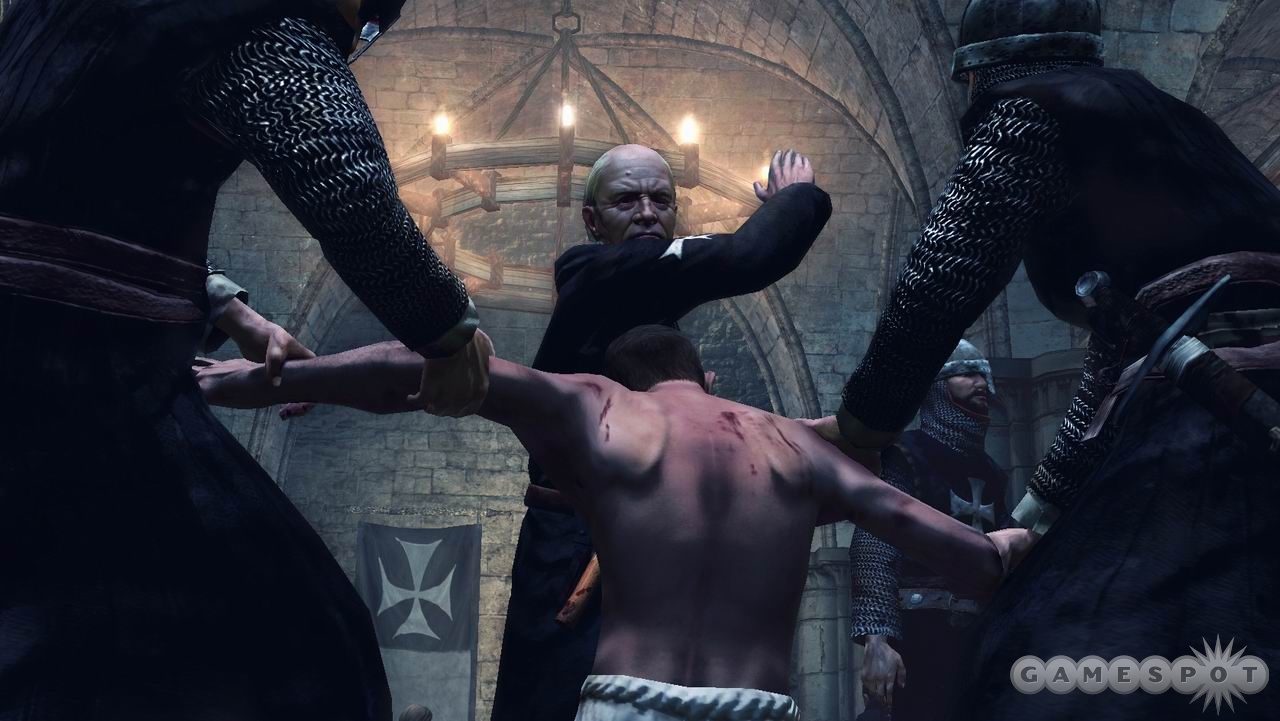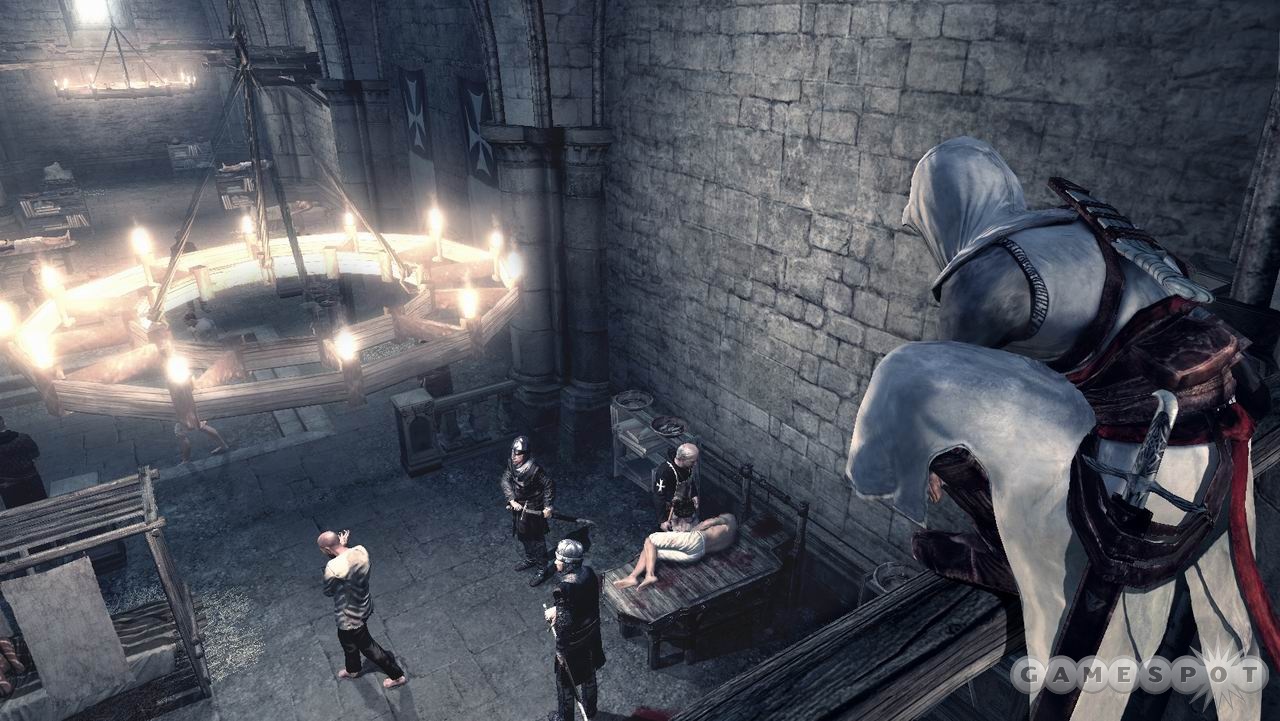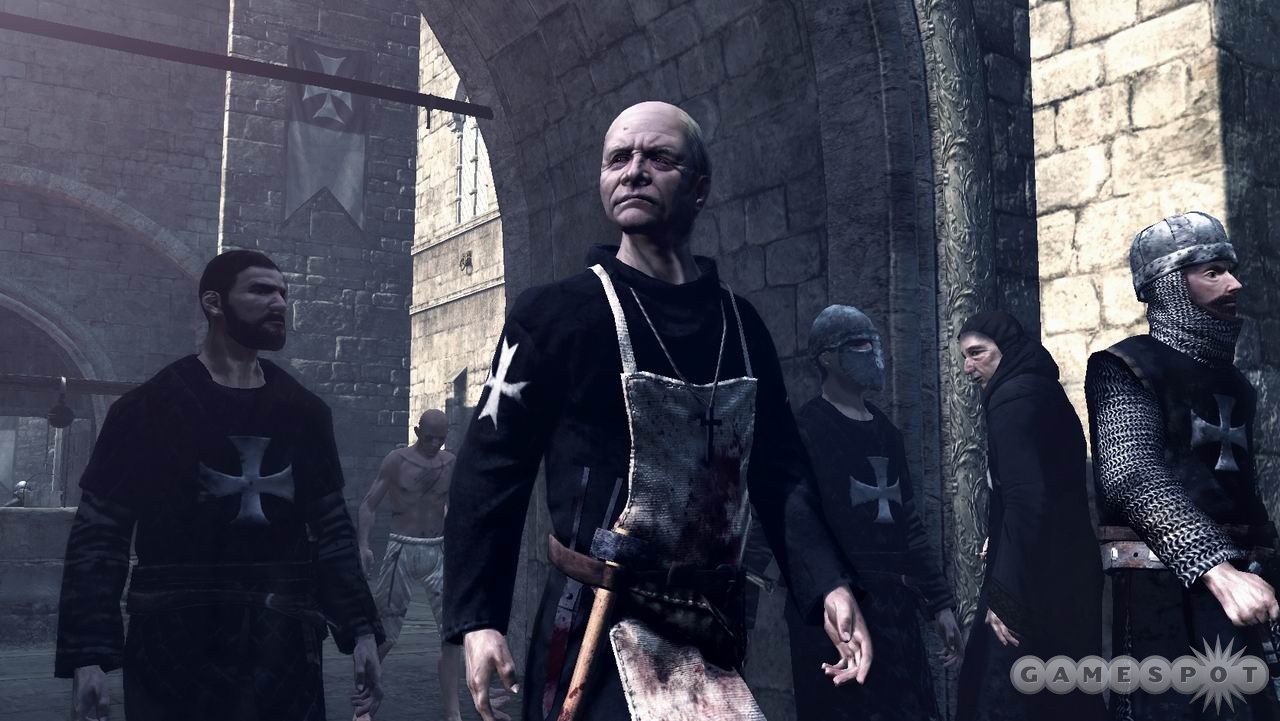Assassin's Creed Updated Hands-On
There's more to Ubisoft Montreal's ambitious action adventure than you might expect. We explored a nearly finished version of the game to find the details.
Assassin's Creed is basically finished. After a four-year development cycle that began right after Prince of Persia: The Sands of Time shipped to retail, the Assassin's team at Ubisoft's renowned Montreal studio is now putting the last touches on the first submission build of the game before it goes into rigorous testing. Sure, bugs will come back from Sony and Microsoft's approval teams, and the developers will have a precious handful of weeks to fix those bugs, optimize the frame rate, and apply that last, vital coat of polish. But the game's feature set, level design, and mission structure are now set in stone. We were pleasantly surprised at the breadth and diversity of the gameplay when we had a chance to sit down with that nearly finished build for an extended tour of Acre, one of Assassin's three primary cities, with a little guidance from creative director Patrice Désilets.

So far, Ubisoft has publicly presented only the core gameplay conceit of Assassin's Creed: You infiltrate the environment, kill your target, and get out--stealthily if you can, but in a hail of arrows if necessary. However, while exploring Acre, we came to realize that you'll be doing much more than simply slaying your way through the Crusades-weary holy land of the late 12th century. The game's three cities--Acre, Jerusalem, and Damascus--will be populated with thousands of citizens going about their business. You'll often have the opportunity to embroil yourself in that business--to your own ends, of course--even when it isn't directly involved with your quest to kill your current target.
First, we'll give you an idea of the general flow of Assassin's Creed. Early in the game, master assassin and main character Altaïr will commit some kind of dire mistake, though the nature of that mistake is unclear. Consequently, his esteem will diminish in the eyes of his assassin's guild and result in the loss of most of his equipment and abilities. It's more than a little reminiscent of that now-classic Metroid design archetype: Start out with everything, lose it all, and spend the rest of the game getting it back. Altaïr's acquisition of new abilities and gear--such as throwing knives for taking out enemies silently at range, or a ledge-grab move that will let you secure a handhold while falling--will correspond to the elimination of his targets. These targets will include notable figures of the Crusades spread out across all three cities, and you'll have the freedom not only to move between those cities at will in an open-world fashion, but also to pursue those targets in any order, within the limits of the storyline.
Ubisoft has been pushing the liveliness of Assassin's Creed's cities, with their vast, teeming citizenry, as one of the game's unique selling points, but we've wondered if this throng would really matter once you're playing the game. We came to find out over the course of our demo that some of those citizens will serve as more than passive obstacles that get in your way when you're fleeing from pursuit. In fact, some of them will act as jumping-off points for optional side missions that you can undertake in-between tracking down and offing your marks. For instance, in each city you'll encounter a number of women being harassed by the city guard. If you choose to step in and help one of these ladies by killing the officers giving her trouble, you'll win the gratitude of her husband...and the vigilante group he happens to belong to. These vigilantes will then remain loyal to you for the rest of the game, so if you get into a scuff in their part of town at any time later, they'll emerge from the crowd and come to your aid to fight against the guards.

Other members of the populace will provide some peripheral benefits as well. Our demo began at the guarded gates of Acre, which we couldn't exactly waltz through unobstructed. We had the unappealing option of simply fighting all the guards at the entrance to get in, or we could use Altaïr's acrobatic abilities to climb up a side wall and get in unnoticed. But we had a third option: We could help out a monk nearby who was in a spat with some other guards a few feet from the gate. We dealt with the guards, which convinced the monk to let us walk slowly through the gates among him and his brethren, whose hooded white robes bore a striking resemblance to Altaïr's own costume. Similar groups of monks can be seen roaming around each city, and you'll be able to immerse yourself in them from time to time to use them as a makeshift hiding place.
Even the process of taking out one of your primary targets will entail more than just heading to an icon on your map and killing one non-player character. When you enter a new city, your first order of business will be to find a "viewpoint," which in the game's parlance means one of the highest points in the city. Viewpoints will include the roofs of the tallest buildings, church steeples, and so on, and these will be both indicated on your map and also evident by, well, their extreme height. Once you climb to a viewpoint, you'll be treated to a sweeping, panoramic view of the city, which will open up more of the map for you. More importantly, it will reveal the location of the closest assassin's bureau, where you'll go to get information on your next target.

However, the hunt doesn't end there. In the demo we played, Altaïr learned of his next target, a cruel and vengeful doctor named Garnier, at the bureau. But he didn't know where Garnier was hanging out, or what his movement patterns might be like. So when you leave a bureau with a new target, you'll begin the investigative phase of each mission, in which you'll track down other specific characters to coerce information out of them. For instance, we had to find a town crier who was standing on some church steps and preaching about the gracious nature of Garnier's medical practices. We followed him into a secluded area and roughed him up to make him spill the beans on the good doctor. In another example, Altaïr had to find a man carrying a letter with valuable information, then sneak up behind him and pick his pocket without alerting him. Each time you accomplish a task in the investigative phase of an assassination, the clues you uncover will lead you back to the bureau or straight to the next informant, as you inch closer to your target.
In gameplay terms, Assassin's Creed ties all of these elements together with the established open-world trappings of Grand Theft Auto and its ilk. That means you get an overhead map of each city with icons indicating the locations of these various gameplay elements, from your next pickpocket or interrogation target, to nearby citizen-rescue missions, and even to the many viewpoints in each city. Speaking of which, the viewpoints will serve as collectible items of a certain kind, and the game will track how many you've found in a city out of the maximum number. There will also be scores of small flags for you to find throughout the game, not unlike Crackdown's agility orbs (though the flags are much less prolific than those). Naturally, viewpoint and flag collection will contribute to achievements in the Xbox 360 version of the game. Although we didn't get to see any action outside Acre itself, we're told that there will also be plenty of all these various gameplay types outside the three cities, in the countryside.
We couldn't help being struck by the brutality of the demo we played--but then, the Crusades weren't the happiest of times for anyone involved. Once Altaïr had located Garnier in the citadel where the good doctor practiced his sadistic brand of medicine, we got to see a cutscene (with Altaïr blending into the crowd) in which Garnier made a public spectacle of a prisoner. After the man threatened to escape his imprisonment, Garnier ordered his guards to publicly shatter the man's legs before returning to his work. Earlier, when Altaïr completed his interrogation of the town crier, the man asked to be spared for providing valuable information. Altaïr simply said "Would that I could," and then gutting the man savagely with his dagger. Between all this and the healthy amount of blood that flows at various times, Ubi Montreal is clearly milking the game's M rating for all it's worth.
Finally, all throughout our time with Assassin's Creed, that sci-fi-tinged hint of narrative ambiguity first revealed at E3 2006 was in the back of our minds. You can see hints of it everywhere in the almost-finished game. Altaïr's health bar and other heads-up display elements look like something out of a futuristic graphical interface. Pausing the game will give numerous references to memory reloads, synchronization, and other technical terms. As we've mentioned before, those characteristic computerized glyphs can be seen when you target enemies and in some other parts of the game world. And remember how we mentioned before that some areas of the city will be blocked until you scope them out from the appropriate viewpoint and complete other necessary tasks? Those barred areas are blocked off by a big blue wall of energy (or something) that bears more of the glyphs. Most mysteriously, every time you kill one of your targets, the game will segue to a cinematic sequence the developers call the "white room," which is a glyph-filled ethereal plane where Altaïr's victim speaks about his role in the Crusades. We've got our own theories as to what all this means, based on what we've seen of the game, but we'll leave the truth's discovery to the player to preserve the impact of that initial experience.
All of these elements of Assassin's Creed are layered on top of the core gameplay mechanics: free-running up building faces and leaping over alleyways, hiding from archers on rooftops, killing your opposition silently, and slinking into the shadows. We had a good feeling that this stuff was going to be cool, but we're duly impressed that there's so much more gameplay Ubisoft has been keeping under wraps all this time. Assassin's Creed is on track for its November release; stay tuned for more on the game in the run-up to its full review.
Got a news tip or want to contact us directly? Email news@gamespot.com
Join the conversation